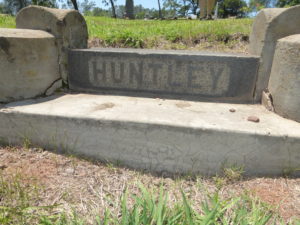Why cemeteries? When researching The Golden Star of Shanghai, I discovered many real and interesting characters that would become important to the book. The Old West, the Gold Rush, and the impact of hydraulic mining has long held fascination to me. Meeting these people, learning their stories over the course of 2 years writing the book, led to “where are they now?” and “I should pay my respects.” Fortunately, I have a wife, Val, who agrees that cemeteries are interesting places, tranquil and contemplative. She read every draft for the book and was eager to see these final resting places, too.
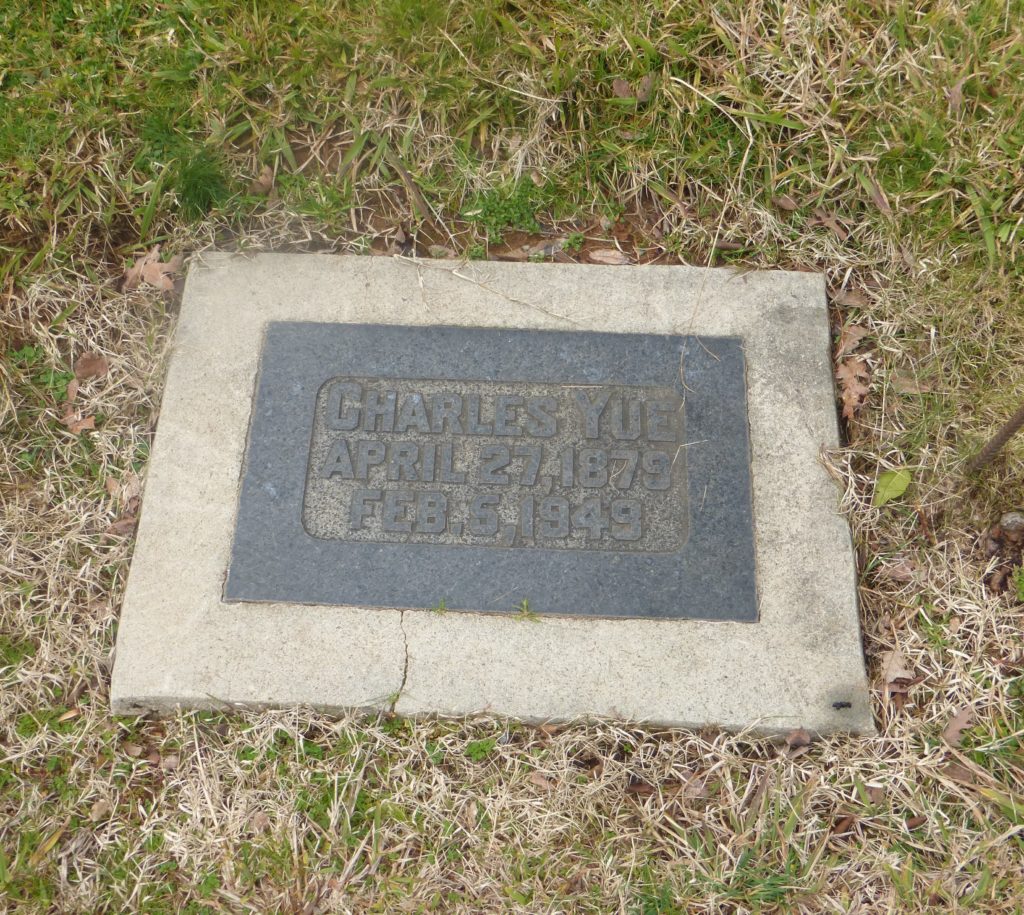
Auburn has a rich and vibrant Chinese history. The city’s Chinatown, located on Sacramento Street and Brewery Lane in Old Town Auburn, operated many businesses, like groceries, restaurants, and laundries. All races depended on these businesses and Auburn gained a reputation as a place tolerant of Chinese residents. This was unlike much of California where anti-Chinese sentiments ran high. In 1876, race riots occurred in the nearby valley towns of Roseville, Rocklin, Penryn, and Folsom. Armed men roved the countryside, driving Chinese residents from their homes and businesses in retribution for a notorious murder. Despite these horrific events, the Chinese presence in Auburn remained intact. The Joss House in Old Auburn remains to this day, dating back to the Gold Rush. Charlie Yue and his sons were an important part of this history, as civic leaders maintaining the Joss House and Chinese Cemetery. They operated The Shanghai Restaurant and Bar from 1906-2005, an amazing run for any business. The location is now the Auburn Ale House, a popular craft beer brew pub, and before that, the inspiration for Charles Townsend Reed and John John’s The Golden Star of Shanghai.
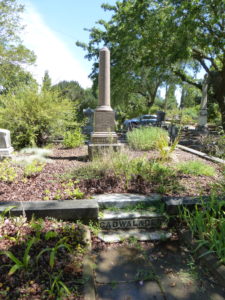
Sacramento Old Historic Cemetery: California has a Hall of Fame and if there is any justice in the world, George Cadwalader, legal counsel for the Anti-Debris Association, who fought the battle to end hydraulic mining, deserves induction. California, the great agricultural colossus, the state we know today, would not have happened without George Cadwalader. It is almost impossible to understate his immense contribution at ridding California of the poisonous environmental damage caused by hydraulic mining, where three times the amount of earth excavated building the Panama Canal was dumped on valley towns, field and orchards. This toxic debris extended all the way from the Sierra Foothills to San Francisco Bay. Cadwalader’s determined advocacy, his cogent arguments, supported by credible and overwhelming evidence, led to the Sawyer Decision, one of the first environmental laws, setting a monumental precedent that would be cited in still more cases all the way to today. The Sawyer decision saved California from becoming a cesspool of pollution for the wealthy few and into the bread box for the entire nation and world. Maria Shriver, Governor Brown, I hereby nominate George Cadwalader for the California Hall of Fame.
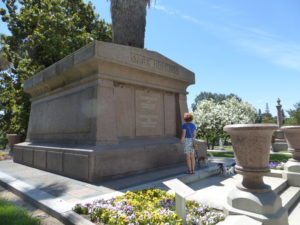
Mark Hopkins, one of the Central Pacific’s Big Four, has a 70 ton granite memorial in Sacramento’s Old Historic Cemetery, just down from George Cadwalader’s grave. Like the tycoons and robber barons of the age, this immense structure shows the outsized wealth of these individuals and if you can’t take it with you, you can certainly build a monument to upstage your neighbors, though I think it looks like an over-the-top maintenance shed.
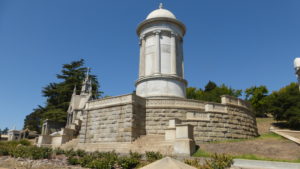
Charles Crocker, Millionaire’s Row, Mountain View Cemetery, Oakland, another monument to wealth and status, and a true Gilded Age tycoon worth hundreds of millions of dollars today. He imported Chinese labor by the thousands as the partner in charge of construction building the Transcontinental Railroad, paying them half the white man’s wages. This caused outrage among native white workers. Crocker was unmoved, stating, “They built the Great Wall, didn’t they?” Crocker’s massive tomb was designed by A. Page Brown, architect of The Ferry Building in San Francisco. Brown was an important figure in the Beaux Arts style and was also instrumental in the Mission Revival style, which provides the visual identity to Santa Barbara, California. Interestingly and coincidentally, Brown died at just age 37, due to injuries caused in a runaway horse and buggy accident in 1896. The same fate befell Crocker. In 1886, New York, Crocker was badly injured in a carriage accident that he never recovered from. He died two years later in Monterey, California, at his Del Monte Hotel/Resort. He was 66 years old.

It was said Crocker’s wife could see the granite column grave from high atop their mansion on Nob Hill, the mansion with the notorious Spite Fence. The mansion, like most of San Francisco, would be destroyed during the great earthquake and fire of 1906. The final postscript to Charles Crocker, when you see his ostentatious tomb, is this quote from The American National Biography that pretty much sums the selfish man up: Crocker “left nothing to charity…nothing to public institutions of any kind.” He was in it for himself, like Ebenezer Scrooge, counting his gains until the end.
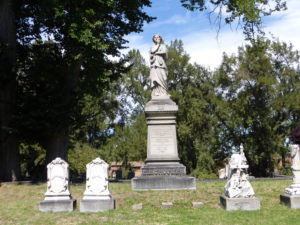
This is unlike his brother Edwin Crocker, legal counsel for the Big Four and before that, in 1863, an appointee to the California Supreme Court selected by then governor Leland Stanford. Edwin would suffer a stroke and die at age 57. His Victorian mansion and European art collection live on as the Crocker Art Museum in Sacramento, California, a very under-rated museum and with its expansion and new galleries, well worth a visit.
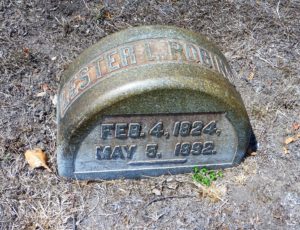
Lester L. Robinson’s humble grave, beside his mother, is the final resting place of a rich man loomed over in death by Crocker’s millions, Millionaires Row, a club Lester could not quite join. I have not been able to locate Robinson’s partner, mentor, lover? Francois Pioche’s grave. If anyone has a tip, please post it to this site. My guess is that Pioche, like Judge Lorenzo Sawyer’s grave was moved to Colma when cemeteries closed in San Francisco due to the scarcity and value of the land. Pioche is a fascinating character who has gone mostly forgotten by the city he, in many ways, created.
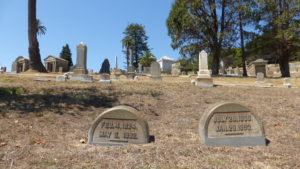
Like George Cadwalader, this is another man who deserves a statue in the town square, and has not received the recognition due him. Perhaps, San Francisco will correct this long overlooked founding father, who built the city’s infrastructure and cultural renown, a Renaissance man interested in everything, from business and industry to food, wine, and art, yet, somehow, is curiously forgotten.

John Craig Boggs, sheriff of Placer County and one of the truly great lawmen of the old west. His name should be as common and as mythic as Wyatt Earp, Bat Masterson, or Seth Bullock. Boggs saw it all as a deputy, constable, and sheriff from the outset of California, especially the mostly lawless early years. State institutions, like the courts and just about any type of government, were beyond weak.
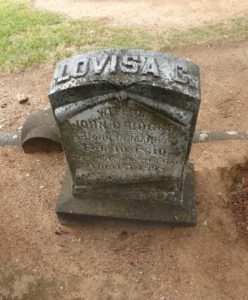
Law enforcement was undermanned and criminals had their way. The trouble really began once the easy to find placer, surface gold was played out. It became much harder to dig deeper and deeper to strike it rich. Many desperate 49ers, having found nothing, turned to crime, claim jumping and outright murder and robbery. The roads were filled with highwaymen and the murder rate, per capita, was much higher during the 1850s than at any time in California history, including the notorious gang/drug street crime scourge of the 1990s. Boggs waded into all of this, steadfast and able. Nothing much scared him and if it was not for him and a small band of law officers, who faced down these challenges, civil society would never have been established in the Golden State.
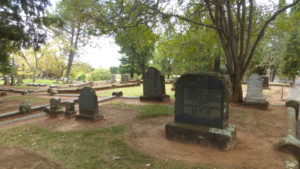
J.C. lived to a ripe old age, finishing his years as one of the most distinguished citizens and as the local postmaster. His grave and those of his wives and children is nestled in a lovely grove of trees at the Newcastle Cemetery, a short distance down the hill from the Auburn Cemetery.
